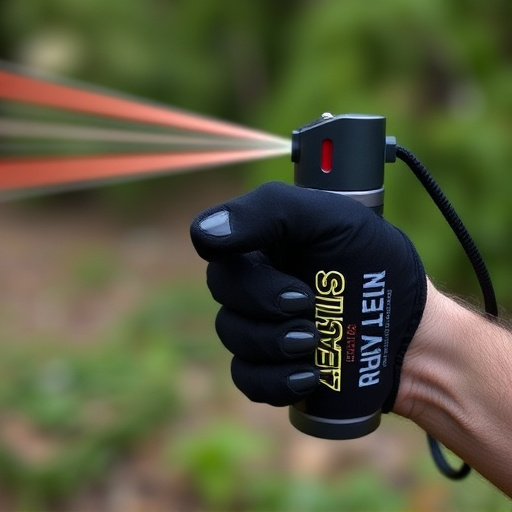Pepper spray, a powerful self-defense tool, uses capsaicin to temporarily disable assailants by targeting TRPV1 pain receptors. To neutralize pepper spray on the face, flush with water for 15+ minutes, apply cold compresses, and seek medical help if irritation persists. Tactical pepper spray is effective against muggers, aggressors, and animals, providing critical escape time. Correct use involves aiming at the eyes, nose, and mouth, with short bursts from a safe distance. Regular practice builds confidence, but users must understand legalities, potential side effects, and responsible deployment techniques to minimize harm.
“Staying safe is a top priority, especially when facing potential threats. This article explores the power of tactical pepper spray as a vital tool for personal defense. We’ll demystify its operation, highlighting how it can neutralize pepper spray on face and disrupt attackers. From understanding its active ingredients to mastering application techniques, you’ll gain insights into effective self-defense strategies. Additionally, we’ll discuss legal aspects and safety tips to ensure responsible usage.”
- Understanding Pepper Spray: How Does it Work?
- The Role of Tactical Pepper Spray in Self-Defense
- Effective Application Techniques for Maximum Protection
- Legal Considerations and Safety Tips for Pepper Spray Usage
Understanding Pepper Spray: How Does it Work?
Pepper spray, also known as oleoresin capsicum (OC) spray, is a non-lethal self-defense tool designed to temporarily incapacitate an assailant by causing discomfort and pain. When deployed, the spray releases a fine aerosolized mist containing capsaicin, the active ingredient found in chili peppers. This irritates the eyes, nose, throat, and skin, leading to coughing, sneezing, difficulty breathing, and temporary blindness.
The primary mechanism of pepper spray is to disrupt normal cellular function by binding to pain receptors, known as TRPV1 channels, which are overstimulated by capsaicin. This overstimulation triggers a cascade of events that result in the symptoms associated with pepper spray exposure. Neutralizing pepper spray on the face involves rinsing the affected area thoroughly with water for at least 15 minutes, applying cold compresses, and seeking medical attention if persistent irritation or respiratory distress occurs.
The Role of Tactical Pepper Spray in Self-Defense
Tactical pepper spray is an essential tool for self-defense, offering a non-lethal way to neutralize potential threats and ensure personal safety. In high-stress situations, it can provide critical seconds for escape or backup, as the irritant can temporarily disable an attacker by impairing vision, breathing, and movement. When deployed effectively, pepper spray allows individuals to defend themselves against muggers, aggressors, or even animal attacks without resorting to deadly force.
The role of tactical pepper spray is especially evident when facing assailants armed with knives or other weapons. It disrupts the attacker’s balance and coordination, giving the victim time to flee or call for help. Moreover, pepper spray can be a strategic tool in close-quarters combat, creating distance between the defender and the aggressor while causing minimal injury. Understanding how to use and deploy it correctly is crucial for maximizing its effectiveness during self-defense scenarios, focusing on aiming for the face to neutralized the threat swiftly.
Effective Application Techniques for Maximum Protection
When it comes to tactical pepper spray, proper application techniques are crucial for maximum self-protection. To effectively neutralize pepper spray on the face, users should aim for the eyes, nose, and mouth. The eyes are particularly vulnerable, as pepper spray can cause severe irritation and temporary blindness. A direct blast towards the face will ensure the highest concentration of capsaecin, the active ingredient in pepper spray, on these sensitive areas.
For optimal results, it’s recommended to use short, controlled bursts of spray. This technique allows for a more precise application, minimizing the risk of accidental exposure while ensuring that the target area receives a strong dose. Additionally, maintaining a safe distance and angling the nozzle correctly can significantly enhance protection against pepper spray. Users should practice these application techniques regularly to build confidence and ensure they’re prepared in case of an emergency.
Legal Considerations and Safety Tips for Pepper Spray Usage
Using tactical pepper spray for self-defense can provide a powerful deterrent against potential attackers, but it’s crucial to understand the legal considerations and safety tips surrounding its use. Each jurisdiction has specific laws governing the possession and application of pepper spray, so users must familiarize themselves with local regulations. Possessing or carrying pepper spray without proper authorization could result in legal consequences.
Before deploying pepper spray, individuals should ensure they have a clear understanding of their rights and responsibilities. It’s essential to aim for non-lethal targets, typically the face and eyes, to neutralize the threat swiftly. Users must also be aware of potential side effects, such as temporary blindness or difficulty breathing, and be prepared to assist anyone affected by the spray. Regular training and practice are vital to ensure effective and safe usage, minimizing harm while maximizing self-defense capabilities.
Pepper spray is a powerful tool for self-defense, designed to neutralize attackers and provide valuable time to escape. Understanding its mechanism, proper application techniques, and legal boundaries ensures effective and safe usage. By mastering the art of deploying tactical pepper spray, individuals can better protect themselves in potentially dangerous situations, empowering them to take control and stay safe.
